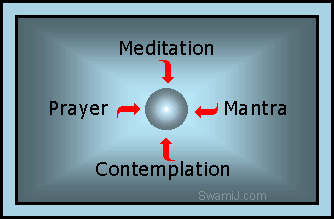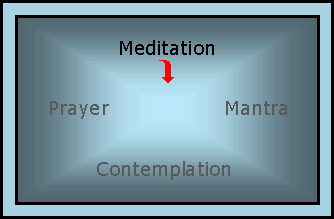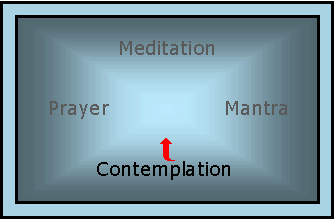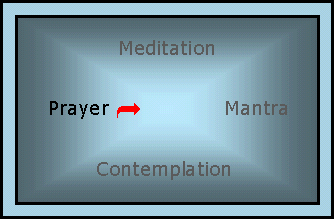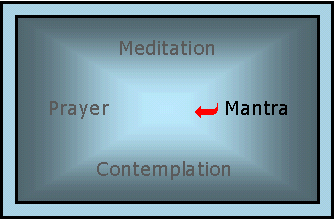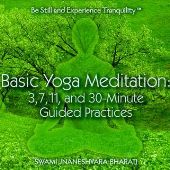|
Home Site Map CDs 50+ Meditations Contemplations 7 Skills Systematic |
||||||||||
|
|
Integrating and Converging Four By practicing each of the
practices of
Contents of this web page: Choose the better of two approaches: Some spiritual traditions or individual teachers may deal with only one or two of the four types of practices. Others, such as the path of Yoga meditation, take a more holistic approach and suggest that one integrate and balance all four of the practices.
Do all of the practices: Yoga meditation of the Himalayas suggests training all of the levels of our being (senses, body, breath, mind), and utilizes a variety of attitude, physical and breathing practices as a foundation. It also teaches one that there is great benefit from doing not only one, but all of the practices of Meditation, Contemplation, Prayer, and Mantra. Follow your predisposition: However, these are not "one size fits all" recommendations, but recognize the predisposition, culture, and religion of individual aspirants. These personal traits are the guidelines by which one chooses the objects of focus for Meditation, the nature of the Contemplations, the emphasis of Prayer, and the specific Mantras. Seek the true meaning of Yoga: Yoga means "union," to re-integrate all of the aspects of our being, that were never really divided in the first place. Thus, it is quite beneficial to work with all levels of our being, and to utilize the full range of practices, adapted to individual needs. To deal with all levels, through such a full range of practices is the true meaning of Yoga. The four work as a team: As these practices of Meditation, Contemplation, Prayer, and Mantra progress to their subtler stages, they become increasingly powerful as a team, moving one to the height of spiritual awakening.
Meditation
Meditation evolves: Meditation evolves in stages, regardless of what object of focus is used, such as breath, a visualized image, an internal point of focus, or a religious symbol. There are several categories or stages in Yoga meditation.
Meditation moves inward: Yoga meditation is systematic, moving inward from gross, to subtle, to subtler, and to subtle-most. Attention moves progressively inward, from the most external to the very core of our being. As attention follows the object inward, the awareness of the grosser aspects of the object fall away, as if being shed, while the deeper essence reveals itself. Mental stance is following: The mental stance of Meditation is one of following the object of meditation, like a bird following a flying insect with unwavering concentration. It is as if the object arose from a deep place, and that by focusing on that object, our attention can follow it back to the source from which it arose. [Words used interchangeably: It is important to note that many traditions and authors use the words "Meditation" and "Contemplation" interchangeably. If we are aware of this, then we can easily see the context of the way the words are being used in different ways. With that clarity, we do not become confused by the terminology. Here, we are using the two words from the approach of Yoga and Vedanta.]
Contemplation
Contemplation evolves: Contemplation also evolves through stages, whether it is a reflection on a universal principle such as, "Truth is in Oneness," an inner question such as, "Who am I?" or on an inspiring verse from the sacred texts of one's religion. In the Himalayan tradition, one of the focuses of Contemplation is on the Mahavakyas, or Great Contemplations.
Contemplation moves inward: Contemplation moves from gross, to subtle, to subtler, and to subtle-most. As attention moves progressively inward, the more external, gross, verbal way of thinking recedes, leading us to the very core of our intuitive being. Mental stance is of inviting: The mental stance of Contemplation is like when you have lost some personal object, such as a key or a pair of glasses. You look and think, look and think, but do not find. Finally, you come to stillness, while your eyes quit roaming, and your mind quits thinking. There is a mental stance of openness, of invitation for the memory to simply arise, as if you were inviting it by saying, "Come....". It is the stance of stillness after the invitation that is Contemplation. Prayer
Prayer evolves: Prayer also evolves through stages, although the specific words and focus of the Prayers might be different for people of different cultures and religions.
Prayer moves inward: Prayer moves from gross, to subtle, to subtler, and to subtle-most. Prayer moves progressively inward, from the most external to the very core of our being, as Prayers such as for strength, or help with going inward, or for spiritual awakening, gradually come to fruition. Mental stance is of anticipation: The mental stance of Prayer is one of anticipation. There is a "Me" and an "Other," and there is a draw, a longing for them to come into presence together. There is a calling forward, an appeal between the heart and the beloved.
Mantra
Mantra evolves: Mantra also evolves through stages, whether the Mantra is of a particular religious significance, such as a short phrase, is of a spiritual language such as Sanskrit, or is a seed syllable not of any particular religion or language. Mantra usage deepens with practice:
Manta moves inward: Mantra moves from gross, to subtle, to subtler, and to subtle-most. Mantra moves progressively inward, from the most external to the very core of our being. Mental stance is of following: The higher mental stance of Mantra is one of following, as if by aligning attention to the Mantra, it will lead one into the Silence from which it arose. The stance is somewhat like listening to the sound of faint, distant music in a forest, where you become physically still, as you strain your attention to identify the source of the sound.
Converging
Integrate the four: As each of the practices deepen in their own special ways, Meditation, Contemplation, Prayer, and Mantra integrate with one another in a dance of the heart and an orchestra of their individuality and synergy.
The four begin to merge: The practices of Meditation, Contemplation, Prayer, and Mantra begin to merge into one another. What at first seemed like very different practices are now seeming to be only most subtly differentiated. Two forces work together: The two stances of experience coming forward (the coming forward of intuition in Contemplation, and of divinity in Prayer), and of attention following inward (the following inward of Meditation and Mantra) combine in their intensity. Together, the practices form two synergistic forces: 1) a powerful magnetism that pulls one further inward towards the Absolute Reality, as 2) the Absolute Reality seems to come forward at the same time. The four converge into one: Finally, as Meditation, Contemplation, Prayer, and Mantra each reach their subtler stages, they converge into one laser like force-field of concentrated awareness, which then pierces the final barrier into the Realization of the Self, the Absolute Reality. Samahitam: The state of deep, inner Silence from which the higher knowledge (Paravidya) begins to come, is called Samahitam. It is the final launching pad, or jumping off place for the direct experience of the Absolute Reality.
-------
|
|
||||||||

